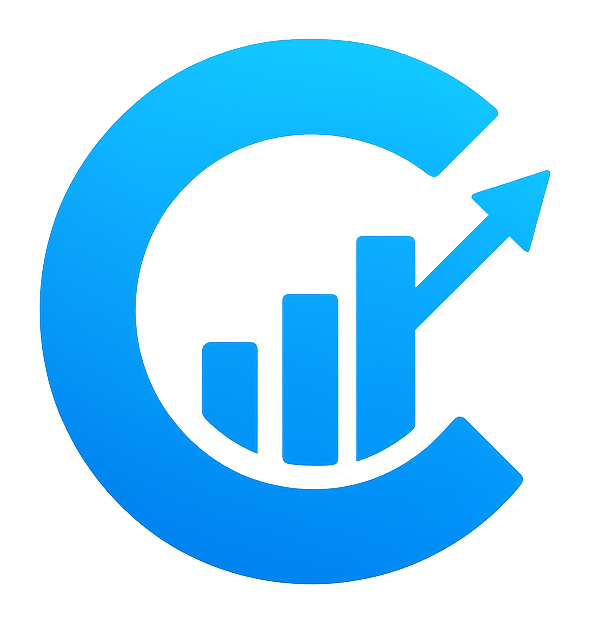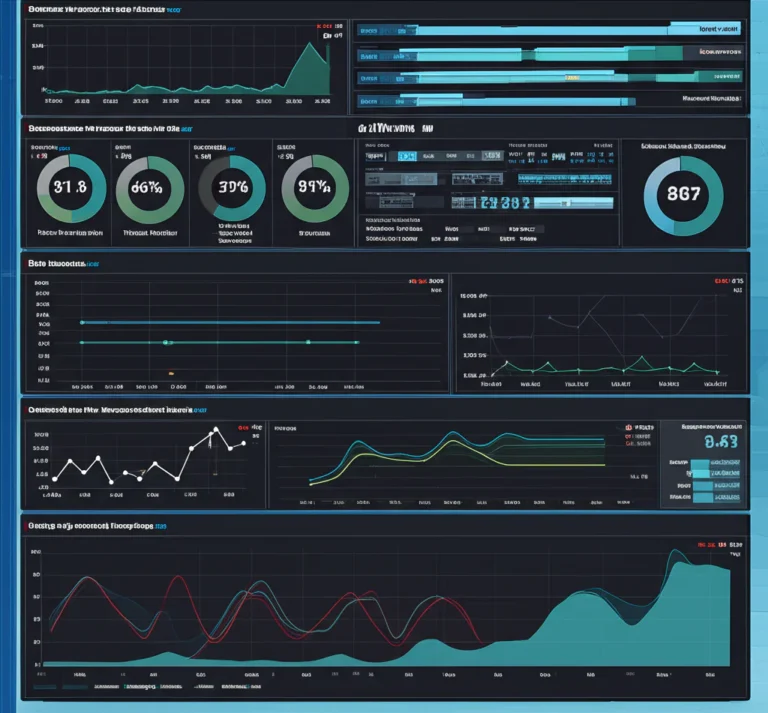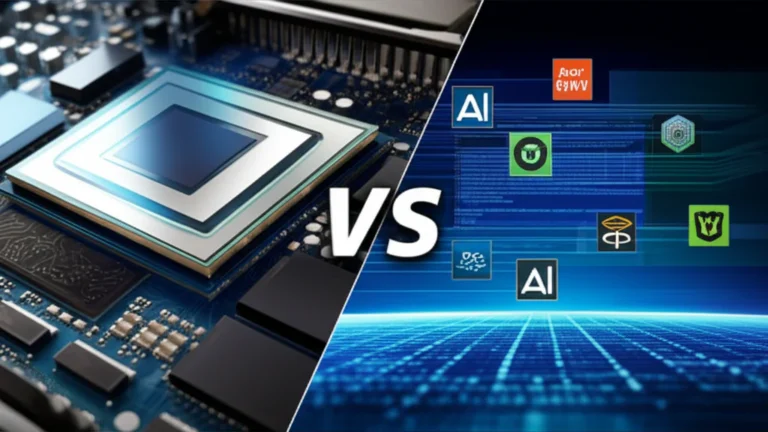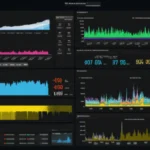Support our educational content for free when you purchase through links on our site. Learn more
How AI Benchmarks Tackle Hardware Variability in 2025 🚀
Imagine trying to compare the speed of a racecar to a bicycle — but both are tested on different terrains, weather conditions, and drivers. That’s exactly the challenge AI researchers face when benchmarking AI frameworks across diverse hardware configurations. From blazing-fast NVIDIA H100 GPUs to energy-efficient mobile SoCs, the performance landscape is wildly variable. So, how do AI benchmarks cut through this chaos to deliver fair, reliable comparisons?
In this article, we unravel the sophisticated methods behind AI benchmarking — from standardized datasets and statistical normalization to containerized environments and hardware-specific tuning. We’ll explore leading benchmark suites like MLPerf and AI Benchmark, dissect the challenges posed by hardware and software diversity, and share expert tips from the ChatBench.org™ team on conducting trustworthy evaluations. Plus, we’ll reveal how these benchmarks inform real-world AI deployment decisions and what the future holds for unified, adaptive benchmarking frameworks.
Ready to decode the secret sauce behind AI benchmarking’s ability to tame hardware variability? Let’s dive in!
Key Takeaways
- Hardware variability causes significant performance swings, making raw benchmark scores misleading without context.
- Standardized datasets, detailed hardware/software documentation, and multiple runs with statistical reporting are essential for fair comparisons.
- Leading benchmarks like MLPerf enforce strict reproducibility protocols and normalize results across hardware architectures.
- Containerization and cloud platforms help minimize environmental noise and improve consistency.
- Understanding benchmark nuances empowers better hardware and framework selection for real-world AI deployments.
For those looking to explore or purchase cutting-edge AI hardware and frameworks, check out our recommended links in the Recommended Links section below.
If you want to learn more about comparing AI frameworks specifically, check out our related article on Can AI benchmarks be used to compare the performance of different AI frameworks?
Table of Contents
- ⚡️ Quick Tips and Facts on AI Benchmarking Variability
- 🔍 Understanding the Evolution of AI Benchmarking Across Hardware
- 🧠 How AI Benchmarks Measure Performance Across Diverse Frameworks and Hardware
- ⚙️ Challenges in Benchmarking AI Frameworks on Varied Hardware Configurations
- 🛠️ Popular AI Benchmark Suites and Their Approaches to Hardware Variability
- 📊 Statistical and Methodological Techniques to Normalize Benchmark Results
- 🔧 Best Practices for Conducting Reliable AI Performance Benchmarks
- 🌐 The Role of Open Source and Community in Benchmark Transparency
- 🚀 Future Trends: Toward Unified and Adaptive AI Benchmarking Frameworks
- 🧩 Integrating AI Benchmark Results into Real-World Deployment Decisions
- 💡 Conclusion: Navigating the Complex Landscape of AI Benchmarking Variability
- 🔗 Recommended Links for Deep Dives and Tools
- ❓ Frequently Asked Questions About AI Benchmarking and Hardware Variability
- 📚 Reference Links and Further Reading
⚡️ Quick Tips and Facts on AI Benchmarking Variability
Welcome to the wild, wonderful world of AI benchmarking! If you’ve ever wondered how AI benchmarks manage to fairly compare AI frameworks running on wildly different hardware setups, you’re in the right place. Here’s a quick cheat sheet from the AI researchers and machine-learning engineers at ChatBench.org™ who specialize in turning AI insight into a competitive edge:
- Hardware variability can cause up to 8% performance swings even when running the same model on different GPUs or clusters. (Source: arXiv 2504.07086v1)
- Software frameworks and evaluation harnesses add another 1-2% variability, due to differences in prompt formatting, inference engines, and response extraction.
- Seed randomness and hyperparameters (temperature, top_p) can shift results by 5-15 percentage points on small benchmarks.
- Concurrency and GPU architecture (e.g., NVIDIA H100 vs H200) significantly affect throughput and latency, impacting real-world AI deployment decisions. (Source: AIMultiple GPU Benchmark)
- Standardized datasets and workloads (ImageNet, AIME’24, MLPerf) are crucial to ensure apples-to-apples comparisons.
- Robust benchmarks report not just mean scores but also variance, confidence intervals, and reproducibility protocols.
- Docker containers and cloud-based standardized environments (e.g., Runpod) help reduce variability.
Curious how all these factors come together? Let’s unpack the history, challenges, and best practices behind AI benchmarking across hardware configurations!
🔍 Understanding the Evolution of AI Benchmarking Across Hardware
Before we dive into the nitty-gritty, it helps to know how AI benchmarking evolved from humble beginnings to the complex ecosystem it is today.
From Whetstone to MLPerf: The Journey
- Early Benchmarks: In the 1970s, benchmarks like Whetstone and Dhrystone measured raw CPU performance using synthetic workloads.
- Real-World Workloads: Later, SPEC CPU and 3DMark introduced more realistic tests for CPUs and GPUs, respectively.
- Energy Efficiency: MobileMark and Green500 benchmarks emerged to measure power consumption alongside performance.
- Rise of AI Benchmarks: As machine learning exploded, domain-specific benchmarks like MLPerf appeared, focusing on training and inference workloads across hardware and software stacks.
Why AI Benchmarking Is Special
Unlike traditional benchmarks, AI benchmarks must handle:
- Probabilistic outputs: Results vary due to randomness in training and inference.
- Diverse hardware: From embedded devices to multi-GPU clusters.
- Complex software stacks: Different frameworks (PyTorch, TensorFlow), drivers (CUDA), and inference engines (vLLM).
This complexity means AI benchmarks must be multi-dimensional and statistically rigorous to be meaningful.
🧠 How AI Benchmarks Measure Performance Across Diverse Frameworks and Hardware
AI benchmarking is a balancing act — measuring performance fairly across frameworks like PyTorch, TensorFlow, JAX, and hardware ranging from NVIDIA GPUs to TPUs and CPUs.
1. Key Metrics Used in AI Benchmarking
Benchmarks evaluate multiple dimensions:
| Metric Type | Examples | Why It Matters |
|---|---|---|
| Accuracy | Top-1 accuracy, BLEU, F1 score | Measures model correctness |
| Throughput | Tokens/sec, images/sec | How many inferences per second |
| Latency | Time to first token, P50/P95 latency | Responsiveness, critical for real-time |
| Resource Use | GPU utilization, memory footprint | Efficiency and cost-effectiveness |
| Energy | Watts, Joules per inference | Sustainability and operational cost |
2. Accounting for Hardware-Specific Optimizations
Hardware vendors like NVIDIA optimize frameworks with libraries (cuDNN, TensorRT) that accelerate specific operations. Benchmarks must:
- Document hardware specs: GPU model, memory, clock speeds.
- Specify software stack: CUDA version, driver, framework versions.
- Allow hardware-specific tuning: E.g., mixed precision (FP16/INT8) to leverage Tensor Cores.
- Normalize results: So a GPU with more cores isn’t unfairly advantaged.
3. Framework Compatibility and Its Impact on Benchmark Results
Different AI frameworks handle model execution differently:
- Inference engines: vLLM vs. native PyTorch can yield different latencies.
- Prompt formatting: Slight changes in input can cause accuracy shifts.
- Random seeds and sampling parameters: Affect output variability.
For example, the arXiv 2504.07086v1 paper found that switching from lighteval to evalchemy changed scores by 1-2 percentage points — enough to affect model rankings.
⚙️ Challenges in Benchmarking AI Frameworks on Varied Hardware Configurations
Benchmarking AI frameworks across hardware is no picnic. Here are the main hurdles:
4. Variability Due to Hardware Architecture Differences
- GPU architectures differ: NVIDIA H100, H200, and B200 have distinct core counts, memory bandwidth, and tensor core designs.
- Memory size and speed: Affect batch sizes and throughput.
- Thermal throttling and cooling: Can cause performance dips on consumer-grade GPUs.
- Cloud vs. on-premises: Shared resources in cloud environments add noise.
5. Influence of Drivers, Firmware, and Software Stacks
- CUDA and cuDNN versions: Newer versions often improve performance but can cause incompatibilities.
- Operating system and kernel: Affect scheduling and resource allocation.
- Framework versions: PyTorch 2.0 vs. 1.13 can yield different results.
- Inference engines: vLLM’s PagedAttention can improve memory efficiency but may behave differently on various GPUs.
6. Reproducibility and Consistency Issues
- Random seeds: High variance in small datasets (5-15% performance swings).
- Prompt engineering: Minor changes can alter results.
- Concurrency effects: Running multiple requests simultaneously can cause resource contention and latency spikes.
- Environmental factors: Background processes, temperature, and network latency.
Pro tip: Use Docker containers and cloud standardized environments like Runpod to minimize variability.
🛠️ Popular AI Benchmark Suites and Their Approaches to Hardware Variability
Let’s peek under the hood of the most influential AI benchmark suites and see how they tackle hardware variability.
7. MLPerf: Setting the Gold Standard
- Scope: Covers training and inference, across datacenter, mobile, client, and tiny devices.
- Hardware documentation: Requires detailed system specs and software stack info.
- Standardized workloads: Uses fixed datasets like ImageNet and SQuAD.
- Reproducibility: Enforces strict run rules, including hyperparameter documentation and multiple runs.
- Energy measurement: MLPerf Power standardizes energy efficiency reporting.
- Community: Open submissions with third-party audits.
8. AI Benchmark by AI Benchmark Team
- Focuses on mobile AI performance across Android devices.
- Measures inference speed, accuracy, and memory usage.
- Accounts for hardware heterogeneity by testing on a wide range of SoCs (Qualcomm Snapdragon, MediaTek, Samsung Exynos).
- Provides detailed reports on hardware-software interplay.
9. DeepBench and Other Specialized Benchmarks
- DeepBench: Microbenchmark focusing on low-level tensor operations (matrix multiplication, convolutions).
- Useful for identifying hardware bottlenecks.
- Helps framework developers optimize kernels for specific GPUs or TPUs.
- Other benchmarks like AIMultiple GPU Benchmark analyze concurrency and throughput under load.
📊 Statistical and Methodological Techniques to Normalize Benchmark Results
How do benchmark designers make sense of noisy, variable data? Here’s the secret sauce:
10. Use of Standardized Workloads and Datasets
- Fixed datasets like ImageNet, COCO, AIME’24, and AMC’23 ensure all models face the same inputs.
- Standardized input sizes and batch sizes reduce variability.
- Publicly available datasets enable reproducibility.
11. Normalization and Scaling Techniques
- Relative performance scores: Benchmarks often report normalized scores relative to a baseline hardware or framework.
- Scaling by hardware specs: Adjusting throughput by GPU TFLOPS or memory bandwidth to compare efficiency.
- Mixed precision adjustments: Accounting for FP16 or INT8 usage.
12. Confidence Intervals and Variance Reporting
- Reporting mean ± standard deviation over multiple runs (≥10 seeds for small datasets).
- Using bootstrapping to stabilize variance estimates.
- Publishing full result distributions, not just averages.
- Highlighting statistical significance to avoid overinterpreting small differences.
🔧 Best Practices for Conducting Reliable AI Performance Benchmarks
Drawing from our experience at ChatBench.org™ and the latest research, here are expert tips for trustworthy benchmarking:
- Document everything: Hardware specs, software versions, hyperparameters, random seeds.
- Use containerization: Docker or Singularity images to freeze software environments.
- Run multiple trials: At least 10 runs for small datasets to capture variability.
- Tune hyperparameters per model: Avoid one-size-fits-all settings.
- Standardize input pipelines: Same batch sizes, data pre-processing, and prompt templates.
- Report variance and confidence intervals: Transparency builds trust.
- Leverage cloud standardized environments: Platforms like Runpod reduce hardware variability.
- Open source your benchmark code and data: Enables community validation and improvement.
- Beware of overfitting to benchmarks: Use diverse datasets and real-world tasks.
🌐 The Role of Open Source and Community in Benchmark Transparency
Transparency is the backbone of credible AI benchmarking.
- Open source benchmark suites like MLPerf, lm-evaluation-harness, and evalchemy allow researchers to inspect and improve evaluation pipelines.
- Community-driven datasets and challenges (e.g., AIME’24) foster reproducibility.
- Public leaderboards encourage fair competition and discourage gaming the system.
- Collaborative platforms enable sharing of Docker images, scripts, and hyperparameter configs.
- Transparency also helps identify hardware lottery effects — where models perform well due to specific hardware optimizations rather than inherent superiority.
🚀 Future Trends: Toward Unified and Adaptive AI Benchmarking Frameworks
The AI benchmarking landscape is evolving rapidly. Here’s what we foresee:
- Adaptive benchmarks: Dynamically adjusting workloads based on hardware capabilities.
- Cross-stack benchmarking: Evaluating hardware, software frameworks, and models together.
- Energy-aware benchmarks: Integrating power consumption as a first-class metric.
- Federated benchmarking: Distributed evaluation across diverse real-world devices.
- AI-driven benchmarking: Using ML to predict performance and identify bottlenecks.
- Standardized containers and cloud APIs: Making benchmarking seamless and reproducible.
- Increased focus on fairness: Mitigating hardware lottery and benchmark engineering biases.
🧩 Integrating AI Benchmark Results into Real-World Deployment Decisions
Benchmarks are not just academic exercises — they guide real-world choices:
- Selecting hardware: Throughput vs. latency trade-offs for batch vs. real-time inference.
- Choosing frameworks: Compatibility and performance on target hardware.
- Cost optimization: Balancing performance with energy consumption and hardware costs.
- Scaling decisions: Understanding concurrency limits and bottlenecks.
- Model tuning: Adjusting hyperparameters based on benchmark insights.
- Risk management: Accounting for variability and reproducibility in SLAs.
At ChatBench.org™, we recommend always combining benchmark data with your specific workload profiles and deployment constraints for best results.
💡 Conclusion: Navigating the Complex Landscape of AI Benchmarking Variability
Phew! That was quite the deep dive, wasn’t it? At ChatBench.org™, we’ve seen firsthand how AI benchmarking is both an art and a science, especially when juggling the wild variability introduced by different hardware configurations and AI frameworks. The key takeaway? No single number tells the whole story. Instead, reliable AI benchmarks embrace complexity by:
- Accounting for hardware heterogeneity — from NVIDIA’s H100 to mobile SoCs — with detailed specs and normalization.
- Controlling software stack differences — documenting CUDA, drivers, frameworks, and inference engines.
- Reporting statistical variance and reproducibility — multiple runs, confidence intervals, and open-source transparency.
- Using standardized datasets and workloads — to ensure fair apples-to-apples comparisons.
- Leveraging containerization and cloud platforms — like Runpod to minimize environmental noise.
By combining these best practices, benchmarks like MLPerf set the gold standard, while specialized suites like AI Benchmark and DeepBench fill in critical gaps. However, challenges remain: hardware lottery effects, overfitting to benchmarks, and evolving AI workloads demand continuous innovation in benchmarking methodologies.
If you’re wondering whether you can trust benchmark results to pick your next AI framework or GPU, the answer is: Yes — but with caution and context. Always look beyond headline numbers. Dive into the details: hardware specs, software versions, variance, and workload relevance. And remember, benchmarks are tools — powerful ones — but your real-world use case is the ultimate judge.
So, next time you see a flashy AI benchmark score, ask yourself: “What hardware? Which framework? How was variability handled?” If the answers are clear and transparent, you’re on solid ground.
🔗 Recommended Links for Deep Dives and Tools
Ready to explore or shop the hardware and tools mentioned? Here are some handy links:
-
NVIDIA GPUs:
-
AI Frameworks & Tools:
-
Benchmark Suites:
-
Books on AI Benchmarking and Performance Engineering:
❓ Frequently Asked Questions About AI Benchmarking and Hardware Variability
What methods are used to standardize AI benchmark results across diverse hardware setups?
Standardization involves multiple layers:
- Detailed hardware and software documentation: Including GPU model, memory, CUDA and driver versions, OS, and framework versions.
- Use of standardized datasets and workloads: Ensuring all models face the same inputs and tasks.
- Containerization: Docker or Singularity images freeze the software environment to reduce variability.
- Multiple runs with statistical reporting: Running benchmarks multiple times (≥10 seeds) and reporting mean, standard deviation, and confidence intervals.
- Normalization techniques: Adjusting performance metrics relative to hardware capabilities (e.g., TFLOPS) or baseline scores.
- Open-source benchmark harnesses: Like MLPerf and lm-evaluation-harness allow community scrutiny and reproducibility.
These methods collectively reduce noise and make results comparable across heterogeneous hardware.
How does hardware variability impact the accuracy of AI framework performance comparisons?
Hardware variability can cause performance differences up to 8% or more even when running the same model and framework. Factors include:
- GPU architecture differences: Core counts, memory bandwidth, tensor core support.
- Driver and firmware versions: Affect low-level optimizations.
- Thermal and power management: Throttling can reduce throughput.
- Cloud vs. on-premises environments: Shared resources and network latency introduce noise.
- Concurrency handling: GPUs behave differently under parallel workloads.
This variability means that benchmark results must be interpreted with caution, considering the hardware context and variance reporting. Without this, comparisons risk being misleading.
What role do AI benchmarks play in optimizing AI frameworks for different computing environments?
AI benchmarks serve as performance compasses guiding framework developers and hardware vendors to:
- Identify bottlenecks: Microbenchmarks like DeepBench pinpoint slow tensor operations.
- Validate optimizations: Testing new CUDA kernels, mixed precision, or inference engines.
- Guide hardware-specific tuning: Frameworks can adapt to GPU architectures for maximal throughput.
- Ensure reproducibility: Standardized benchmarks verify that improvements hold across environments.
- Inform trade-offs: Between accuracy, latency, throughput, and energy consumption.
Ultimately, benchmarks accelerate innovation by providing objective feedback loops for optimization.
How can businesses leverage AI benchmark insights to improve hardware and software integration?
Businesses can use benchmark insights to:
- Select appropriate hardware: Balancing throughput, latency, and energy efficiency for their workloads.
- Choose compatible AI frameworks: Ensuring software stack stability and performance on target hardware.
- Optimize deployment pipelines: Using concurrency and batch size data to scale inference efficiently.
- Forecast costs: Understanding resource utilization and energy consumption for budgeting.
- Mitigate risks: Accounting for variability and reproducibility in SLAs and performance guarantees.
- Drive R&D: Benchmark-driven tuning and model selection improve product competitiveness.
By integrating benchmarking data into decision-making, businesses gain a competitive edge in AI deployment.
Additional FAQs
How do concurrency and batch size affect AI benchmark results?
Concurrency (number of simultaneous requests) and batch size impact GPU utilization and latency. Higher concurrency can increase throughput but may raise latency and resource contention. Benchmarks like those using vLLM measure these trade-offs to guide deployment strategies.
Why is reproducibility a major concern in AI benchmarking?
Because AI models and hardware stacks are complex and stochastic, small changes can cause large performance swings. Reproducibility ensures that results are reliable and not artifacts of random chance or specific environments.
📚 Reference Links and Further Reading
- arXiv:2504.07086v1 — On Variability in AI Benchmarking
- AIMultiple GPU Benchmark Analysis
- MLSysBook: Benchmarking Machine Learning Systems
- MLPerf Official Website
- NVIDIA Data Center GPUs
- PyTorch Framework
- TensorFlow Framework
- Runpod Cloud GPU Platform
- vLLM Inference Engine GitHub
- AI Benchmark Team Website
- DeepBench by Baidu GitHub
For a comprehensive exploration of Performance Engineering Benchmarking AI, see the MLSysBook chapter on Benchmarking.
We hope this guide from ChatBench.org™ helps you confidently navigate the complex terrain of AI benchmarking across diverse hardware configurations. Happy benchmarking! 🚀




